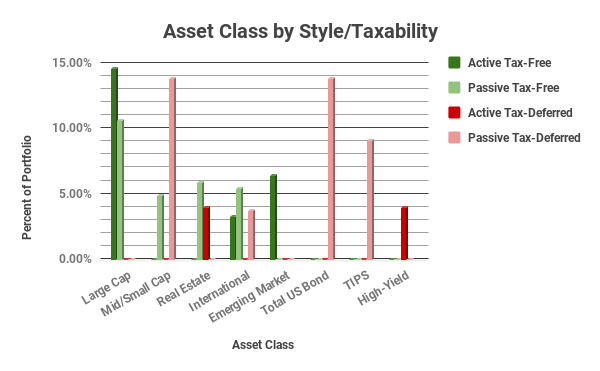pb4uski
Give me a museum and I'll fill it. (Picasso) Give me a forum ...
1. $500 stock doubles to $1,000, $500 bond increases to $585, total of $1,585 before taxes.... and I'll assume Roth conversion rather than withdrawal for simplicity.
2. $500 stock increase to $600, $500 bond increases to $585, total of $1,185 before taxes.... and I'll assume Roth conversion rather than withdrawal for simplicity.
3. $500 stock decrease to $450, $500 bond increases to $585, total of $1,035 before taxes.... and I'll assume Roth conversion rather than withdrawal for simplicity.
However, return in all scenarios is the same as the $1,000 increases in value to $1,585, $1,185 and $1,035, for scenarios 1, 2 and 3 respectively... resulting in returns of 16.59%, 5.82% and 1.15%, respectively. The investment risk is the same as well.
However, the placement of assets for tax efficiency results in different after-tax values, as would be expected.... IOW, the different terminal values after taxes are a consequence of differences in tax efficient placement and not AA.
- $500 stocks in Roth and $500 bonds in tIRA = AA of 55/45 increase to $1,000 stocks in Roth and $585 in bonds in tIRA.... resulting in $117 in taxes and $1,468 in Roth
- $500 bonds in Roth and $500 stocks in tIRA = AA of 45/55 increase to $585 bonds in Roth and $1,000 in tIRA, resulting in $200 in taxes and $1,385 in Roth
- $250 stocks and $250 bonds in Roth and $250 stocks and $250 bonds in tIRA = AA of 50/50 increase to $500k stocks and $293 bonds in tIRA and $500 stocks and $292 bonds in tIRA, resulting in $158 in taxes and $1,427 in the Roth.
2. $500 stock increase to $600, $500 bond increases to $585, total of $1,185 before taxes.... and I'll assume Roth conversion rather than withdrawal for simplicity.
- $500 stocks in Roth and $500 bonds in tIRA = AA of 55/45 increase to $600 stocks in Roth and $585 in bonds in tIRA.... resulting in $117 in taxes and $1,068 in Roth
- $500 bonds in Roth and $500 stocks in tIRA = AA of 45/55 increase to $585 bonds in Roth and $600 in tIRA, resulting in $120 in taxes and $1,065 in Roth
- $250 stocks and $250 bonds in Roth and $250 stocks and $250 bonds in tIRA = AA of 50/50 increase to $300k stocks and $293 bonds in tIRA and $300 stocks and $292 bonds in tIRA, resulting in $118 in taxes and $1,067 in the Roth.
3. $500 stock decrease to $450, $500 bond increases to $585, total of $1,035 before taxes.... and I'll assume Roth conversion rather than withdrawal for simplicity.
- $500 stocks in Roth and $500 bonds in tIRA = AA of 55/45 increase to $450 stocks in Roth and $585 in bonds in tIRA.... resulting in $117 in taxes and $918 in Roth
- $500 bonds in Roth and $500 stocks in tIRA = AA of 45/55 increase to $585 bonds in Roth and $450 in tIRA, resulting in $90 in taxes and $945 in Roth
- $250 stocks and $250 bonds in Roth and $250 stocks and $250 bonds in tIRA = AA of 50/50 increase to $225k stocks and $293 bonds in tIRA and $225 stocks and $292 bonds in tIRA, resulting in $103 in taxes and $932 in the Roth.
However, return in all scenarios is the same as the $1,000 increases in value to $1,585, $1,185 and $1,035, for scenarios 1, 2 and 3 respectively... resulting in returns of 16.59%, 5.82% and 1.15%, respectively. The investment risk is the same as well.
However, the placement of assets for tax efficiency results in different after-tax values, as would be expected.... IOW, the different terminal values after taxes are a consequence of differences in tax efficient placement and not AA.
Last edited:

